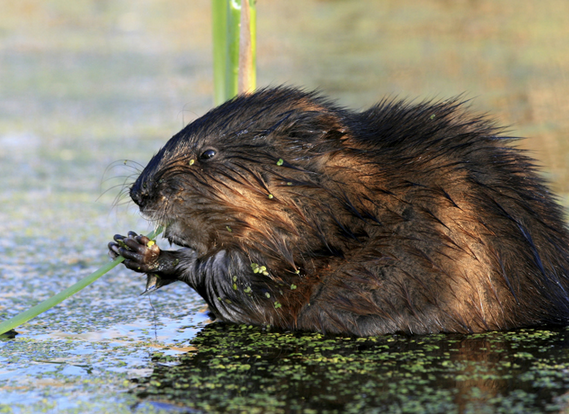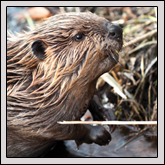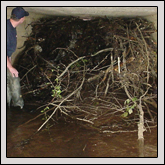Beaver Management Helps Landowners
North Carolina works to resolve conflicts between beavers and people.
Farm Bureau |
North Carolina wildlife experts believe people and beavers share a common attribute that makes them unique from other members of the animal kingdom.
“Beavers are the only animals besides people that can really manipulate their habitat according to what they need,” says Colleen Olfenbuttel, the black bear and furbearer biologist for the North Carolina Wildlife Resources Commission.
Because of that ability to alter surroundings that best fit them, people and beavers often intersect—especially here in North Carolina. It’s why there has been a comprehensive plan in place for almost 20 years to ensure beavers can thrive while farmers and other landowners can enjoy and use their property.
“The North Carolina Beaver Management Assistance Program has been highly successful and proven and saved millions of dollars in damage to agriculture, roads, timber and other structures,” says Olfenbuttel, who also chairs the program’s advisory board, which includes two representatives from North Carolina Farm Bureau.
“It’s really helped people resolve their problems when they really weren’t sure what they could do. We’re pretty proud of this program and the savings it’s provided North Carolina,” she adds.
Why the Program Is Needed
 Olfenbuttel estimates about 500,000 beavers live in North Carolina, a figure she says is conservative because of how the animal’s population has rebounded strongly in the past 30 years. She says beavers live in all 100 counties but predominantly can be found in the Piedmont and Coastal Plain. Those regions contain many more slower-moving streams, lakes and ponds that appeal much more to beavers than rockier territory and stronger currents found within the state’s mountains.
Olfenbuttel estimates about 500,000 beavers live in North Carolina, a figure she says is conservative because of how the animal’s population has rebounded strongly in the past 30 years. She says beavers live in all 100 counties but predominantly can be found in the Piedmont and Coastal Plain. Those regions contain many more slower-moving streams, lakes and ponds that appeal much more to beavers than rockier territory and stronger currents found within the state’s mountains.
In rare cases, North Carolina beavers can become as large as 80 pounds, but Olfenbuttel says most are a fraction of that weight or size.
Near the beginning of the 1900s, beavers nearly were eradicated in this state because of the value of their fur and lack of regulation that limited hunting and trapping. The establishment of harvesting guidelines and declining value for beaver fur during the 1960s and ’70s allowed the animal’s population to rise again.
With more beavers came more problems.
“There are conflicts in how the beaver wants to use a person’s property and how a person needs to use their property,” Olfenbuttel says. These conflicts can range from fertile farmland being inundated with water that cannot run off easily to roadway and railway bridges being compromised because they have become beaver dam foundations.
 North Carolina’s Response to Rising Beaver Population
North Carolina’s Response to Rising Beaver Population
Jon Heisterberg serves as North Carolina’s state director for U.S. Department of Agriculture Wildlife Services. Heisterberg arrived here back in 1989, three years before the General Assembly established the beaver management program as a pilot initiative in four counties—Bladen, Brunswick, Robeson and Sampson.
Heisterberg says immediate success propelled the program to be utilized by the Department of Transportation in all 100 counties. Forty-two counties also contribute $4,000 annually to the program so residents in those areas can obtain discounted services if a beaver dam is causing a nuisance.
“We are getting a better handle on things in individual counties that have participated in the program for a number of years. It’s easier to address recurring problems,” Heisterberg says.
How Beavers and Dams Are Removed
Beaver and dam removal begins when a farmer, landowner or DOT official spots an issue that likely stems from animal activity and contacts USDA Wildlife Services, which has a team of 18 professionals who cover the state and orchestrate the management program.
“We don’t necessarily remove the beavers and the dams just because someone might not like beavers. They have to have a reason why, and 95 percent of the time they do,” Heisterberg says.
The USDA team usually makes several visits to the dam site to assess the situation and plan strategy. Humane traps are used to catch the beavers and precise explosives are utilized if the dam cannot be taken down simply by hand.
“One thing people always might have a misconception about is that beavers live in the dam. They don’t,” Heisterberg says. “They just build the dam to flood water behind the dam. That’s where the put their lodges. They feel protected when they’re in water so the whole idea is to flood things as much as they can then they can swim to where they need to go.”
Beyond removing the dam itself, Heisterberg stresses that all of the beavers, that reside at the location must be caught and taken away, too.
“It doesn’t do any good to remove the dam without removing the beavers because you can remove the dam and that same night the beavers have come back to build the dam back up again,” Heisterberg says. “You have to do both in concert or you’re not going to get anywhere.”
Future of Beavers in North Carolina
 While it may appear beavers are predominantly a nuisance in North Carolina, Olfenbuttel reminds residents about the good these animals can do.
While it may appear beavers are predominantly a nuisance in North Carolina, Olfenbuttel reminds residents about the good these animals can do.
“They do have benefits. When they manipulate a habitat it can cause problems but sometimes they can create wetlands. And then that wetland can create a habitat for a host of other wildlife species such as waterfowl,” Olfenbuttel says.
“In the end, the beaver is quite complex,” she adds. “We just try to encourage people to view beavers from both angles: one as an engineer who can create wildlife habitat here in North Carolina, but also recognize that they can cause conflict. That’s when we step in and do something to prevent that conflict from occurring.”



Is it common for a beaver to be in the city limits of Raleigh, NC? I was able to capture photos of one in our neighbors yard; however, have never seen them here prior.
I own property in a Mitchell Co development that has a small 5 acre lake. One side of the lake is wooded. There is a small creek that feeds the lake in addition to being spring-fed.
One neighbor is up in arms because a beaver may have cut some trees on the wooded side of the lake.
Should we be alarmed or can we just enjoy the fact that wildlife is enjoying our lake?
I have 5 acres in Brunswick County NC.. I have lived there for 25 years and for the last 5 years the Beavers have been building dams in the ditch that was dug years before me for Mosquito Control.. The county have been coming each year to clean the ditch out but because they are closed right now due to the Virus they cannot help me.. I have a pond close to the ditch that has flood all my property. I lost my house to a fire 1 1/2 year ago. I can not build back because of the flooding. My pasture is under water. Trees are dying and falling. The property on the other side of the ditch is flooded and all the trees that are dying fall onto my property causing a bigger problem.. I need help. My property is being destroyed by the Beavers and I have to rent until I can build back.. This is a nightmare. Can someone HELP !!!!!
Hi my name is Chris cooper I am a licensed trapper in North Carolina and would like to help you with your beaver problem no cost to you I live and work in Brunswick County my number is 910-269-5822
We have had a beaver dam on my property. Has not been a problem for 20 plus years . Family had worked clearing brush for last two years putting up lights for a large wedding planned on bank of pond and cabin located on Bearskin swamp . We were not notified of removing dam . Neighbors kids had enjoyed fishing and boating on pond . Why was dam removed without consulting with landowners ? Not a DOT or timber problem.
We have had a beaver dam on my property. Has not been a problem for 20 plus years . Family had worked clearing brush for last two years putting up lights for a large wedding planned on bank of pond and cabin located on Bearskin swamp . We were not notified of removing dam . Neighbors kids have enjoyed fishing boating and just watching habitat from endangered species of plants and animals . No one has notified me nor the other land owner. I’m very interested in any assessment if any actually done . Today it stinks-of high heaven from all the dead fish . Looks like catfish water dogs are dying in large numbers .
Need help with beaver management in Nash County. Call 252-314-6327.